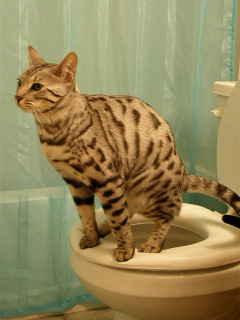Hazards of Flushing Cat Poop Down Your Toilet - Prevent Possible Problems
Hazards of Flushing Cat Poop Down Your Toilet - Prevent Possible Problems
Blog Article
What are your opinions about Don’t flush cat feces down the toilet?

Intro
As pet cat owners, it's necessary to be mindful of just how we dispose of our feline good friends' waste. While it might appear hassle-free to flush feline poop down the bathroom, this technique can have detrimental consequences for both the environment and human health.
Environmental Impact
Flushing cat poop introduces damaging microorganisms and bloodsuckers into the water system, positioning a significant risk to aquatic communities. These contaminants can adversely impact marine life and compromise water quality.
Health Risks
In addition to environmental concerns, purging pet cat waste can likewise position health dangers to people. Feline feces may contain Toxoplasma gondii, a bloodsucker that can create toxoplasmosis-- a possibly serious disease, particularly for expectant ladies and individuals with weakened body immune systems.
Alternatives to Flushing
Luckily, there are safer and more liable methods to get rid of feline poop. Consider the adhering to options:
1. Scoop and Dispose in Trash
The most usual technique of taking care of pet cat poop is to scoop it into a biodegradable bag and throw it in the garbage. Make sure to use a dedicated clutter inside story and dispose of the waste quickly.
2. Use Biodegradable Litter
Select eco-friendly cat litter made from products such as corn or wheat. These litters are eco-friendly and can be safely disposed of in the garbage.
3. Bury in the Yard
If you have a backyard, consider hiding feline waste in a marked area far from vegetable yards and water sources. Make certain to dig deep sufficient to avoid contamination of groundwater.
4. Mount a Pet Waste Disposal System
Purchase a family pet waste disposal system particularly designed for feline waste. These systems make use of enzymes to break down the waste, decreasing smell and environmental influence.
Conclusion
Accountable pet dog ownership prolongs past offering food and sanctuary-- it likewise includes correct waste monitoring. By refraining from purging pet cat poop down the toilet and selecting different disposal methods, we can lessen our environmental footprint and secure human health.
Why Can’t I Flush Cat Poop?
It Spreads a Parasite
Cats are frequently infected with a parasite called toxoplasma gondii. The parasite causes an infection called toxoplasmosis. It is usually harmless to cats. The parasite only uses cat poop as a host for its eggs. Otherwise, the cat’s immune system usually keeps the infection at low enough levels to maintain its own health. But it does not stop the develop of eggs. These eggs are tiny and surprisingly tough. They may survive for a year before they begin to grow. But that’s the problem.
Our wastewater system is not designed to deal with toxoplasmosis eggs. Instead, most eggs will flush from your toilet into sewers and wastewater management plants. After the sewage is treated for many other harmful things in it, it is typically released into local rivers, lakes, or oceans. Here, the toxoplasmosis eggs can find new hosts, including starfish, crabs, otters, and many other wildlife. For many, this is a significant risk to their health. Toxoplasmosis can also end up infecting water sources that are important for agriculture, which means our deer, pigs, and sheep can get infected too.
Is There Risk to Humans?
There can be a risk to human life from flushing cat poop down the toilet. If you do so, the parasites from your cat’s poop can end up in shellfish, game animals, or livestock. If this meat is then served raw or undercooked, the people who eat it can get sick.
In fact, according to the CDC, 40 million people in the United States are infected with toxoplasma gondii. They get it from exposure to infected seafood, or from some kind of cat poop contamination, like drinking from a stream that is contaminated or touching anything that has come into contact with cat poop. That includes just cleaning a cat litter box.
Most people who get infected with these parasites will not develop any symptoms. However, for pregnant women or for those with compromised immune systems, the parasite can cause severe health problems.
How to Handle Cat Poop
The best way to handle cat poop is actually to clean the box more often. The eggs that the parasite sheds will not become active until one to five days after the cat poops. That means that if you clean daily, you’re much less likely to come into direct contact with infectious eggs.
That said, always dispose of cat poop in the garbage and not down the toilet. Wash your hands before and after you clean the litter box, and bring the bag of poop right outside to your garbage bins.
https://trenchlesssolutionsusa.com/why-cant-i-flush-cat-poop/

I recently found that write up on Can You Flush Cat Poo or Litter Down the Toilet? when doing a search on the web. In case you enjoyed our post kindly remember to share it. Thanks a lot for your time. Please visit our site back soon.
Get A Free Estimate Report this page